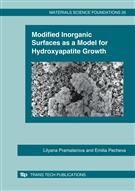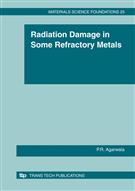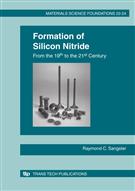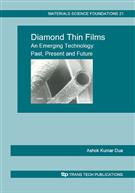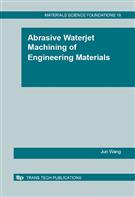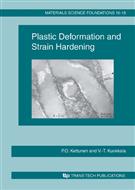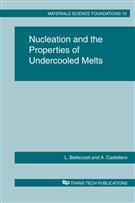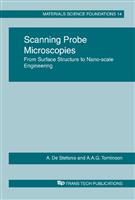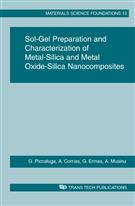Engineering Research
Advanced Engineering Forum
Applied Mechanics and Materials
Engineering Chemistry
Engineering Innovations
Journal of Biomimetics, Biomaterials and Biomedical Engineering
International Journal of Engineering Research in Africa
Materials Science
Advanced Materials Research
Defect and Diffusion Forum
Diffusion Foundations and Materials Applications
Journal of Metastable and Nanocrystalline Materials
Journal of Nano Research
Key Engineering Materials
Materials Science Forum
Nano Hybrids and Composites
Solid State Phenomena
Engineering Series
Advances in Science and Technology
Construction Technologies and Architecture
Engineering Headway
Foundations of Materials Science and Engineering
Volume in the series: 26
Authors:
Lilyana Pramatarova and Emilia Pecheva
The process by which organisms in Nature create minerals is known as biomineralization - a process that involves complex interactions between inorganic ions, crystals and organic molecules; resulting in a controlled nucleation and growth of minerals from aqueous solutions. During the last few decades, biomineralization has been intensively studied, due to its involvement in a wide range of biological events; starting with the formation of bones, teeth, cartilage, shells, coral (so-called physiological mineralization) and encompassing pathological mineralization, i.e. the formation of kidney stones, dental calculi, osteoporosis, arteriosclerosis, osteogenesis imperfecta, etc. During the same period, biomineralization has become a hot topic for world-wide research throughout the world, due to the growing expectations of a good quality and duration of life by the ever-increasing population of the aged. Young people, in particular, also make increasing demands on the quality and the appearance of the existing implants available on the market. The general goals of research and manufacture are now to create and improve implants for various applications in the human body, as well as to prevent diseases leading to the formation of minerals such as hydroxyapatite (implicated, for example, in osteogenesis, kidney stones, dental calculi, arteriosclerosis – all problems which mainly affect women).
The results presented in this book will make a significant contribution to the application of the modified surfaces of widely-studied materials as a model system for hydroxyapatite-coating, to the cultivation of cells on surfaces, as well as to the growth of hydroxyapatite by applying new technologies (such as laser-liquid-solid interaction) that facilitate nucleation and growth. In this way, materials and layers having possible applications as implants, biosensors, etc. can be obtained. The in vitro system described here is universal and can be applied not only to the production of hydroxyapatite coatings for implants, but also to investigating the basic mechanisms of mineral-formation diseases and thus identify new directions for prophylaxis. This will then make a strong contribution to improving the quality and duration of life of the population.
The results presented in this book will make a significant contribution to the application of the modified surfaces of widely-studied materials as a model system for hydroxyapatite-coating, to the cultivation of cells on surfaces, as well as to the growth of hydroxyapatite by applying new technologies (such as laser-liquid-solid interaction) that facilitate nucleation and growth. In this way, materials and layers having possible applications as implants, biosensors, etc. can be obtained. The in vitro system described here is universal and can be applied not only to the production of hydroxyapatite coatings for implants, but also to investigating the basic mechanisms of mineral-formation diseases and thus identify new directions for prophylaxis. This will then make a strong contribution to improving the quality and duration of life of the population.
eBook:
$88.00
Volume in the series: 25
Authors:
Prof. R.P. Agarwala
In Chapter–1 of this timely book, radiation damage in vanadium, niobium, molybdenum and tungsten is discussed at the atomic level; treating – for instance - third-stage recovery in terms of self-interstitials being mobile traps for - predominantly - vacancies. Higher recovery stages are treated by using various techniques, such as: electrical resistivity, electron microscopy, positron annihilation spectroscopy and computer simulation - thus revealing vacancy-cluster break-up in stage-V and interstitial cluster annealing in stage-VI.
eBook:
$88.00
Volume in the series: 22-24
Authors:
Raymond C. Sangster
The elements: Si, N, O, C and H, have strong chemical affinities for one another. Under the correct conditions, Si-N bonding will occur in almost any Si-N-(O/C/H), and many related, reaction systems; although Si-O and Si-C are formidable competitors to Si-N. The most favored Si-N compound is stoichiometric Si3N4. It comes in three common varieties. How they interrelate, how one finds them and (above all ) how one makes them - and how sometimes they just happen to form - are the subjects of this book, with due attention being paid to closely related matters.
eBook:
$198.00
Volume in the series: 21
Authors:
Ashok Kumar Dua
Diamond, as well as being a precious gem, is a versatile material par excellence. No other material comes anywhere near to matching its properties, which are both extreme, and also expressed in rare combinations. However, natural diamonds, and those synthesised under high sandpressure temperatures, are too expensive or small for many technological applications. These limitations can be overcome by using large-area diamond coatings; chemically bonded to inexpensive non-diamond surfaces. The consequent economic advantages provide the driving force for much diamond-related research and technology.
eBook:
$88.00
Volume in the series: 20
Authors:
Prof. R.P. Agarwala
eBook:
$88.00
Volume in the series: 19
Authors:
Jun Wang
Manufacturing industry is becoming ever more time-conscious with regard to the global economy, and the need for rapid prototyping and small production batches is increasing. These trends have placed a premium on the use of new and advanced technologies for quickly turning raw materials into usable goods; with no time being required for tooling. The need for advanced processing technologies is particularly evident when machining advanced materials, such as ceramics, composites and thermo-sensitive materials that have wide application but are considered to be "difficult-to-machine" using conventional machining technologies such as turning and milling. Abrasive waterjet (AWJ) machining has been found to be one of the advanced technologies that meet these processing requirements; due to its distinct advantages over other machining technologies.
eBook:
$77.00
Volume in the series: 16-18
Authors:
P.O. Kettunen, V.T. Kuokkala
This publication is based upon lectures given during a well-received course on physical metallurgy and originally intended for students specializing in fields related to metallic materials. But, as the author points out, metallic materials are the most widely investigated group of materials and their study therefore gives a good basis for understanding how other materials can be made to reveal interrelationships between their structures and properties; especially with regard to those properties associated with strain. Similar types of rule can then be applied to other materials, in spite of their apparent differences.
eBook:
$198.00
Volume in the series: 15
Authors:
L. Battezzati and A. Castellero
Nucleation is a central topic in Materials Science because it initiates most phase transformations. When a new phase appears within an existing phase, seeds must form before growth can occur within the given volume. The study of nucleation treats the very early stages, which involve only a limited number of atoms or molecules. It is a branch of fundamental research which has far-reaching implications for processes where nucleation is of paramount relevance to phase and microstructure selection. The development of any new material or processing route always leads to renewed interest in the topic.
eBook:
$77.00
Volume in the series: 14
Authors:
A. De Stefanis and A.A.G. Tomlinson
In the 1990s, there was a considerable development in molecular chemistry through super- and supra-supermolecular stages. These featured large molecular arrays, from interlocked organic macromolecules, nanotubes, dendrimers, polyphenylenes, and many others - especially self-assembling molecules (SAM) - in repeating units in the 5 – 100 nm range. Simultaneously, materials science, and especially electronics, is still going down from microns to nanometers through utilisation of ever-shorter wavelengths in beam lithographies on substrates, especially silicon ones. In addition, unconventional fabrication methods for patterning nanostructures (again for electronics and optoelectronics) are also emerging, at the same time overlapping with other fields where mesoscopic order is responsible for function, such as bio-ordering (shells, plate ordering in animal shells and wings, DNA-derived assemblies, and so on).
eBook:
$77.00
Volume in the series: 13
Authors:
G. Piccaluga, A. Corrias, G. Ennas, A. Musinu
Materials with nanometer size particles exhibit unique chemical and physical properties. In particular, nanocomposite materials, composed of nanometric metal and metal oxide particles embedded in vitreous matrices, present a variety of interesting magnetic, electric and catalytic properties, that are strongly size-dependent. Among the different preparation methods which can be used to obtain this kind of materials, the sol-gel process is particularly interesting because it is affected by several parameters which allow a versatile control of the structural, textural and chemical properties of the final products. The present volume focusses on the preparation of metal-silica and metal oxide-silica (Me=Ni, Fe, Zn) nanocomposites by the sol-gel method and the characterization of their structural and magnetic properties.
eBook:
$77.00
